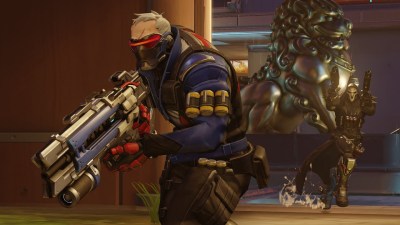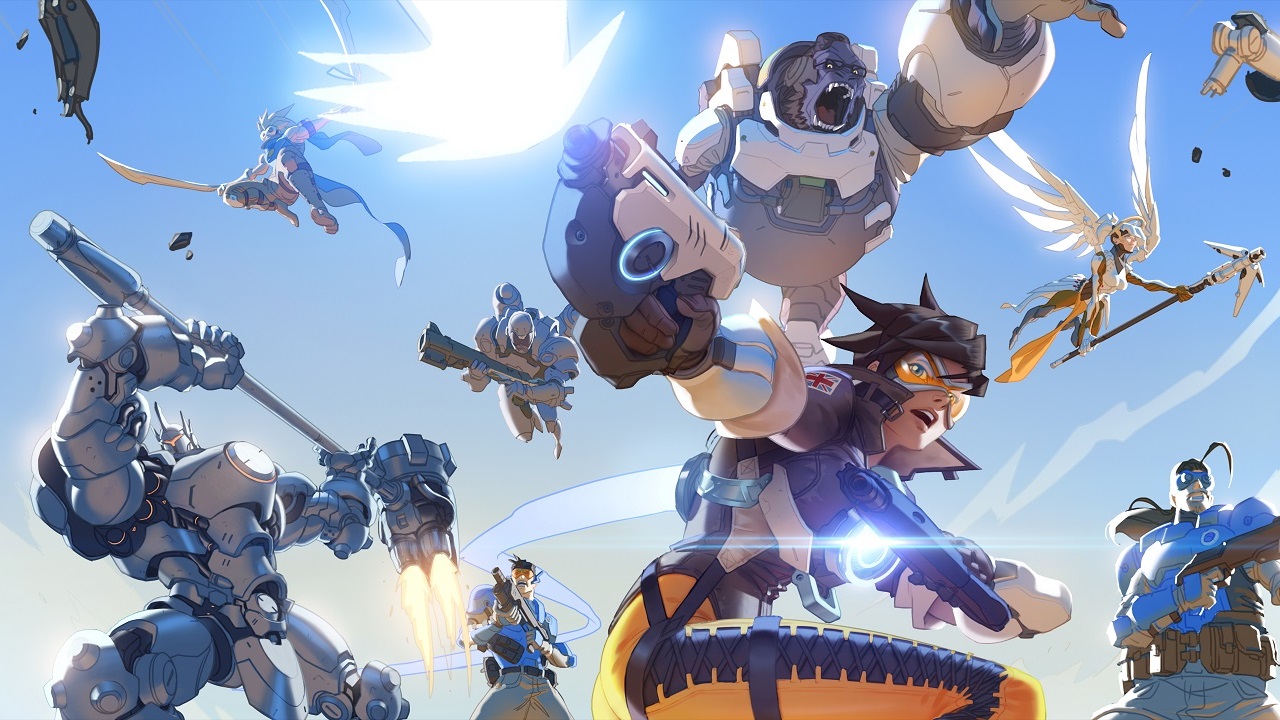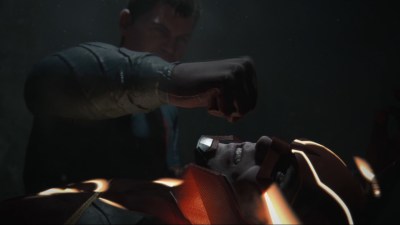Blizzard’s first original setting in 17 years was always going to turn heads. This is a company that has steadfastly relied on its existing IP to see it through, with even new games like Hearthstone and Heroes of the Storm drawing on characters and settings established decades ago. For close to twenty years, the universes of Warcraft, Starcraft and Diablo have formed the holy trinity of Blizzard’s output, bringing the company unprecedented success and smashing sales records. The company’s success is such that Blizzard is one of the few development studios to have its own annual convention.
The addition of a new universe to the Blizzard pantheon is A Big Deal™, then. It’s an even bigger deal when Overwatch sees the veteran developer turning its hand to a genre it has no prior experience with - the competitive multiplayer FPS. The gaming landscape is dominated by the likes of Battlefield, Call of Duty and Team Fortress 2; it’s only natural to wonder if a developer with no track record in the genre could turn out a game capable of competing with those juggernauts on its first attempt.
 Amazingly, Blizzard has managed exactly that. If you’re currently sat on the fence, wondering why you should care about Overwatch, there’s a good reason why you should seriously consider taking the plunge. There’s 21 of them, in fact.
Amazingly, Blizzard has managed exactly that. If you’re currently sat on the fence, wondering why you should care about Overwatch, there’s a good reason why you should seriously consider taking the plunge. There’s 21 of them, in fact.
Overwatch’s playable heroes (and villains) are a strong reminder of just how accomplished Blizzard is when it comes to character design. Overwatch plays like a dream; its maps are intricately designed warrens, rife with strategic opportunities; and its presentation rivals Pixar for universal appeal and polish. But make no mistake, Overwatch‘s cast of 21 playable heroes are the real stars of the show, and what will keep you coming back to it again and again.
Blizzard knows this, and doesn’t waste an opportunity to ensure that you do, too. Load up the game, and a randomly chosen hero dominates the menu screen. All of the promotional material surrounding the game has focused on different characters and their relationships with one another. Overwatch is all about the heroes - and Blizzard may have created its most loveable cast of characters yet. Whether it’s a super-intelligent gorilla, a levitating android monk, or a pro gamer piloting a mech, Overwatch has a character for everyone.
Each character draws from well-known archetypes existing in fantasy, sci-fi, and all imaginable subgenres; but what could have ended up feeling like a kitchen sink approach to world building instead feels remarakably cohesive. As diverse as the cast is, they still somehow manage to feel as though they belong together.
In the absence of a single player campaign (Overwatch is a strictly multiplayer-only affair), it’s surprising how well Blizzard has managed to give each character its own distinct personality, as well as flesh out the relationships between them. There are no cutscenes to speak of, no collectibles that unlock log entries - but if two characters happen to find themselves on the same team in a round, they’ll share snippets of dialogue that hints at their backstory and establishes their personality in a just a few short lines. I want to know more about Overwatch’s history, the rift between Solider 76 and Reaper, Widowmaker’s heel-turn from Hero into Villain, and the bad blood between brothers Hanzo and Genji.
flesh out the relationships between them. There are no cutscenes to speak of, no collectibles that unlock log entries - but if two characters happen to find themselves on the same team in a round, they’ll share snippets of dialogue that hints at their backstory and establishes their personality in a just a few short lines. I want to know more about Overwatch’s history, the rift between Solider 76 and Reaper, Widowmaker’s heel-turn from Hero into Villain, and the bad blood between brothers Hanzo and Genji.
But appearance and personality aren’t the only thing separating these heroes: they also have their own unique set of abilities, many of which synnergise in ways that can turn the tide of a match. Overwatch has found itself compared to many other games, often erroneously - League of Legends, Battleborn, Team Fortress 2. While Overwatch shares some DNA with those titles, it was another game that keeps springing to mind when playing: Street Fighter. Both Overwatch and Street Fighter have a diverse cast of playable combatants, with their own movesets. Every ability has a counter. The character select screen is ripped right out of the 90s heyday of fighting games, complete with larger-than-life character poses and bombastic music.
Sure, Street Fighter is a one-on-one fighting game, and Overwatch is a team-based competitive first person shooter. But a game of Overwatch, just like Capcom’s flagship franchise, feels like a fast-paced game of chess. Both teams are constantly attempting to out-maneuver the other, anticipate each other’s moves, and laying on pressure in the hope of gaining an advantage. This is amplified by Overwatch‘s unique selling point - you’re not stuck with playing as a single character for the duration of a match.
Upon death, you’re taken back to the character select screen while you wait to respawn - another example of Blizzard placing its characters front and centre. The flexibility afforded to matches by allowing you to mix things up can’t be overstated. Team lineups are in a state of constant flux, both sides reacting to each other and the state of the game, creating an almost breathless sense of pace. Playing as the angelic healer Mercy, you might be taken down by an opponent playing as Bastion, a giant robot capable of transforming into a stationary, bullet-spewing turret. So you’ll switch to the cybernetic ninja Genji, who can deflect Bastion’s bullets and easily hack him to pieces in moments - only to find yourself scuppered by Junkrat, who is able to lay down immobilizing steel traps; or Mei, whose freeze gun can see you encased in ice. While you play, a meter on screen tracks how close you are to being able to unleash a character’s ultimate ability. Hanzo’s ultimate sees him unleashing a pair of giant spirit dragons that tear through anyone unfortunate enough to find themselves caught in their path; Mercy, meanwhile, can mass-ressurect all downed team members. My favorite so far is Junkrat’s ultimate, which sees you suddenly piloting an explosive tyre into the middle of the enemy team. Used at the right time, it can cause utter carnage.
With 21 characters and the ability to freely switch between them, there’s an almost infinite number of potential team combinations. This variety keeps Overwatch feeling fresh despite the relatively small number of maps on offer. At launch, Overwatch features 12 maps, split among a small number of modes (typically a variant of escorting a payload or capturing strategic points on the map). As well designed and aesthetically pleasing as these maps are (and they really are gorgeous), if it wasn’t for the frantic gameplay resulting from the character swapping mechanic, they’d grow old quickly. But the shifting team lineups prevent this, with the result that your hundredth match on a map feels just as fresh as your first. In games like Call of Duty and Halo, map layout is king. In Overwatch, it’s almost incidental - mere window dressing for the frantic action taking place as two teams of six players fight it out.
That’s not to say that the maps aren’t worth mentioning, however, or that they don’t feel like inhabitable spaces. Much like its colorful cast, Overwatch‘s maps reinforce a distinctly international flavor. Each stage is modelled on a specific location around the world, from Greece to Russia to London, and Blizzard’s artists have managed to tease out the atmosphere of a place without being bound by it. Illios takes place against a clear blue sky, its crumbling white pillars standing in contrast against verdant greenery; Big Ben’s clock tower (amusingly transformed into a digital clock) looms over a maze of narrow alleyways and rooftops in King’s Row, illuminated by moonlight. Much like its heroes, Overwatch‘s locations are based more on stereotype and popular culture than reality; but they manage to evoke the spirit of their real-life counterpart surprisingly well.
They also feature multiple routes, many of which are inaccessible unless you’re playing as a particular character. While the revolver-toting cowboy McCree is largely relegated to fighting on the ground, Widowmaker can utilize her grapple hook to reach sniping spots and call out enemy positions. Mei’s ice walls may primarily serve as a way to block off enemy routes - but she can also climb them, gaining access to areas that would otherwise be inaccessible.
Manage to pull off something particularly impressive during a bout, and you might find your feat replayed at the end of the match in what Overwatch labels as “Play of the Game”. It’s a great way to rub salt into the wounds of the enemy team, as well as grant you bragging rights among your fellow teammates. At the moment though, it has a tendency to focus on killing sprees, with the unfortunate side effect that support heroes such as Mercy and Lucio are often unfairly ignored. Blizzard has promised to fix this in an upcoming patch.
As with most other shooters these days, you gain XP at the end of each game and gradually level up your profile. Unlike many of its contemporaries, levelling up in Overwatch doesn’t unlock additional loadout options or special abilities. Instead, gaining a level sees you rewarded with a Loot Crate containing four randomly chosen cosmetic items - alternative character skins, victory poses, emotes and grafitti.
If you receive an item that you’ve already unlocked, the game automatically converts it to a small amount of currency that can then be used towards the cost of an unlock of your choice. You can also purchase loot crates with real money through the online store. While this would normally be a cause for concern, the fact that all loot is purely cosmetic neatly sidesteps any worries of players gaining an advantage purely because they’ve spent more real money. It also enables Blizzard to promise that all future characters, modes and maps will be released as free updates, avoiding the problem of paid-for map packs fragmenting the community - an issue that has plagued other multiplayer-focused titles, notably Destiny and Call of Duty.
As with any online-focused game, Overwatch will live or die based on the size of its community. Blizzard has certainly delivered the goods on the quality front, and Overwatch has the same one-more-go appeal and sense of reward that has been key to the success of its other titles.
The sole concern I have right now is whether it will be able to deliver new heroes, maps and modes regularly enough to stop players losing interest. If Blizzard manages to put out new content on a monthly basis and build on the excellent foundation laid down at launch, then I strongly believe that Overwatch has a bright future ahead of it - one that it certainly deserves. If updates are few and far between, however, then there’s a risk that its community could find itself looking elsewhere - whether that’s back to rival multiplayer shooters or even to Blizzard’s other titles.
Blizzard’s track record in this area is a little spotty. While Hearthstone and Heroes of the Storm have enjoyed substantial new content since launch, the developer has also found itself coming under criticism for taking too long between updates for World of Warcraft and Diablo on occasion.
None of that detracts from what Blizzard has achieved with Overwatch, however. While some may turn their nose up at the lack of single player content, to do so would be a disservice to what has been delivered. Fiendishly addictive, incredibly fun to play and overflowing with Blizzard’s signature surplus of polish, Overwatch is one of the most enjoyable shooters on the market right now - and a strong contender for Game of the Year.




